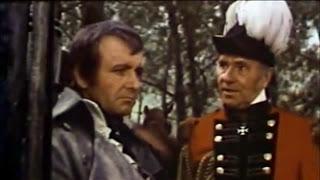
"Anyone can make use of a friend. The trick is to use one's enemies."
Eagle in a Cage (1972) began life as a 1960s television play starring Trevor Howard, only to be expanded for a slightly larger theatrical version. Hampered by a limited budget, Fielder Cook's drama nonetheless retains interest for its smart script and a game cast.Napoleon Bonaparte (Kenneth Haigh) is exiled to St. Helena after his defeat at Waterloo. He immediately butts heads with Sir Hudson Lowe (Ralph Richardson), the island's governor who relishes his power over the defeated Emperor. Nonetheless, Napoleon reconnects with ex-mistress Madame Bertrand (Billie Whitelaw), several of his aides (Moses Gunn and Ferdy Mayne) and beriends his Irish doctor, Barry O'Meare (Michael Williams). He chafes at his imprisonment, constantly plotting escape until Britain's devious Lord Sissal (John Gielgud) arrives with a tantalizing offer.
Though filmed on location in Croatia, Eagle in a Cage isn't especially cinematic. Cook's visuals are mostly pedestrian, with Frano Vodopivec's static widescreen shots crossed with static dialog scenes. The movie does attain conventional thrills at the midpoint, when Napoleon attempts an escape by clambering over mountain cliffs, pursued by dozens of British soldiers. Mostly though, Eagle's staging is functional rather than exciting.
Which is fine, because writer Millard Lampbell has an ear for cutting dialog and sharp characterizations. Eagle takes flight probing Napoleon's dilemma, still hungering for a return to glory but forced to accommodate his reduced circumstances. The gradual deflation of his delusions provides rich drama, as he confronts his past in still-loyal aides, defiant Brits and scornful lovers. Napoleon insists upon justifying his achievements, which O'Meare punctures by listing his concomitant crimes. Meanwhile, he balances relationships with Betty (Georgina Howe), a star-struck Briton who admires his image, and Bertrand, who recognizes Bonaparte as he truly is.
Meanwhile, his jailers consider him alternately dangerous and useful. While Lowe wants him humiliated as a token of British victory, Lord Sissal views him as a potential pawn in affecting the Concert of Europe. As Louis XVIII's regime in France descends into chaos, the English wonder whether a pliant Napoleon would be preferable. The best scene has Napoleon negotiating with Sissal, Napoleon manipulating the Englishman's weakness while Sissal alternately threatens and plays to the Emperor's vanity. Played with knowing cynicism and cutting humor, it's a perfect picture of power politics.
Kenneth Haigh does commendably subtle, intelligent work, mating Napoleon's outsized personality with his insecurities and growing realization of insignificance. It's layered performance from an actor largely wasted on film, never able to match his legendary stage career. The supporting cast scores with richly shaded turns: Michael Williams a mischievous foil to Napoleon, Ralph Richardson masking sadism within gentile propriety, Billie Whitelaw resentful and harping, John Gielgud grouchily devious.
Despite its shortcomings, Eagle in a Cage still provides discerning viewers a compelling historical drama. In its intelligent depiction of powerful men angling for advantage, it's a shame that the staging isn't more lavish and accessible.

